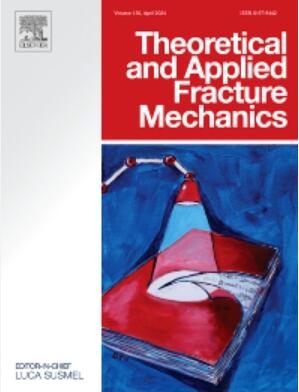A Machine learning model to predict fracture of solder joints considering geometrical and environmental factors
IF 5
2区 工程技术
Q1 ENGINEERING, MECHANICAL
引用次数: 0
Abstract
Predicting the fracture load and energy in solder joints is crucial for enhancing their reliability and preventing failure in electronic systems. This study introduced a novel framework by combining experimental data, machine learning (ML) models, and multi-objective optimization to predict and optimize the fracture behavior of solder joints. For this purpose, double cantilever beam (DCB) samples were fabricated and tested under displacement-control conditions and mode I crack propagation loading with a strain rate of 0.03 , incorporating environmental factors (i.e., storage temperature and humidity) and geometrical constraints (i.e., adherend thickness, adherend width, and solder thickness). The one-way analysis of variance (ANOVA) test results revealed that while all studied factors affected the fracture load of the joints, only storage temperature, humidity, and adherend thickness meaningfully influenced the samples’ fracture energy. Next, using various machine learning (ML) techniques such as artificial neural network (ANN) and random forest (RF), the solder joint’s fracture load and energy were forecasted with 86 % and 80.5 % accuracy, respectively. According to the results, the ANN and RF models predicted the joint fracture load and energy more accurately than other ML algorithms. Finally, a multi-objective optimization was employed to achieve fracture load and energy optimal values in DCB specimens by implementing the NSGA-II algorithm. This integrated approach can minimize the need for experimental testing and enable accurate prediction of solder joint fracture behavior by employing various ML models and optimization algorithms considering different working conditions.
求助全文
约1分钟内获得全文
求助全文
来源期刊

Theoretical and Applied Fracture Mechanics
工程技术-工程:机械
CiteScore
8.40
自引率
18.90%
发文量
435
审稿时长
37 days
期刊介绍:
Theoretical and Applied Fracture Mechanics'' aims & scopes have been re-designed to cover both the theoretical, applied, and numerical aspects associated with those cracking related phenomena taking place, at a micro-, meso-, and macroscopic level, in materials/components/structures of any kind.
The journal aims to cover the cracking/mechanical behaviour of materials/components/structures in those situations involving both time-independent and time-dependent system of external forces/moments (such as, for instance, quasi-static, impulsive, impact, blasting, creep, contact, and fatigue loading). Since, under the above circumstances, the mechanical behaviour of cracked materials/components/structures is also affected by the environmental conditions, the journal would consider also those theoretical/experimental research works investigating the effect of external variables such as, for instance, the effect of corrosive environments as well as of high/low-temperature.
 求助内容:
求助内容: 应助结果提醒方式:
应助结果提醒方式:


